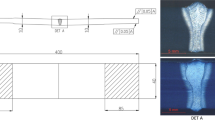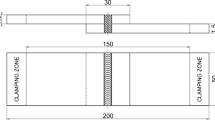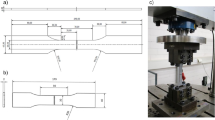Abstract
Ti–6Al–4V is an alloy increasingly used in aeronautics due to its high mechanical properties coupled with lightness. An effective technology used to manufacture titanium components with a reduced buy-to-fly ratio is laser beam welding. Previous studies showed that the key factor that rules the mechanical properties and the fatigue life of the joint is its morphology. The aims of this paper were to investigate the influence of the geometrical features of the joints (height of the top and root reinforcement, depth and radius of the underfill, and the valley–valley underfill distance) on their mechanical properties and also to conduct a finite element (FE) analysis on the real geometry of the welded joints. Ti–6Al–4V rolled sheets 3.2 mm thick were welded in butt joint configuration using a laser source and their performance was studied in terms of weld morphology, microstructure, Vickers microhardness and fatigue life. A full factorial plan, designed varying the welding speed and laser power, was carried out. The real geometry and then the joint morphology were studied through an innovative approach: for each specimen, both the total weld face and the total root surface were acquired using a confocal microscope. Finally, through these acquisitions, the clouds of points of the scanned surfaces were used in order to carry out a FE analysis capable of providing a stress concentration factor, K t , value for each detected joint. The main results are the realization of a reliable FE model by an experimental agreement and the relationship found amongst the fatigue performances and some noticeable metallurgical and geometrical features, such as the underfill depth and the aspect ratio defined as the ratio between the maximum height of the joint and the valley–valley underfill distance.
Similar content being viewed by others
References
Squillace A, Prisco U, Ciliberto S, Astarita A (2012) Effect of welding parameters on morphology and mechanical properties of Ti–6Al–4V laser beam welded butt joints. J Mater Process Technol 212:427–436. doi:10.1016/j.jmatprotec.2011.10.005
Boyer RR (1996) An overview on the use of titanium in the aerospace industry. Mater Sci Eng A 213:103–114. doi:10.1016/0921-5093(96)10233-1
Akman E, Demir A, Canel T, Sinmazçelik T (2009) Laser welding of Ti6Al4V titanium alloys. J Mater Process Technol 209:3705–3713. doi:10.1016/j.jmatprotec.2008.08.026
Cao X, Jahazi M (2009) Effect of welding speed on butt joint quality of Ti–6Al–4V alloy welded using a high-power Nd:YAG laser. Opt Laser Eng 47:1231–1241. doi:10.1016/j.optlaseng.2009.05.010
Boccarusso L, Arleo G, Astarita A, Bernardo F, De Fazio P, Durante M, Giudice G, Minutolo Memola Capece F, Sepe R, Squillace A (2015) Effect of the process parameters on the geometrical defects of Ti–6Al–4V hot rolled sheets laser beam welded. Key Eng Mater 651–653:901–906. doi:10.4028/www.scientific.net/KEM.651-653.901
Gao XL, Zhang LJ, Liu J, Zhang JX (2014) Effects of weld cross-section profiles and microstructure on properties of pulsed Nd:YAG laser welding of Ti6Al4V sheet. Int J Adv Manuf Technol 72:895–903. doi:10.1007/s00170-014-5722-x
Chen HC, Pinkerton AJ, Li L (2011) Fibre laser welding of dissimilar alloys of Ti–6Al–4V and Inconel 718 for aerospace applications. Int J Adv Manuf Technol 52:977–987. doi:10.1007/s00170-010-2791-3
Yang M, Qi B, Cong B, Liu F, Yang Z (2013) Effect of pulse frequency on microstructure and properties of Ti–6Al–4V by ultrahigh-frequency pulse gas tungsten arc welding. Int J Adv Manuf Technol 68:19–31. doi:10.1007/s00170-013-4822-3
Wang S, Wu X (2012) Investigation on the microstructure and mechanical properties of Ti–6Al–4V alloy joints with electron beam welding. Mater Des 36:663–670. doi:10.1016/j.matdes.2011.11.068
Kabir ASH, Cao X, Medraj M, Wanjara P, Cuddy J, Birur A (2010) Effect of welding speed and defocusing distance on the quality of laser welded Ti–6Al–4V. Mater Sci Technol Conference Exhib 2010 4:2787–2797
Gao XL, Zhang LJ, Liu J, Zhang JX (2013) A comparative study of pulsed Nd:YAG laser welding and TIG welding of thin Ti6Al4V titanium alloy plate. Mater Sci Eng A 559:14–21. doi:10.1016/j.msea.2012.06.016
Caiazzo F, Curcio F, Daurelio G, Memola Capece Minutolo F (2004) Ti6Al4V sheets lap and butt joints carried out by CO2 laser: mechanical and morphological characterization. J Mater Process Technol 149:546–552. doi:10.1016/j.jmatprotec.2003.12.026
Armentani E, Esposito R, Sepe R (2006) Finite element analysis of residual stresses on butt welded joints. Proceedings of 8th Biennial ASME Conference on Engineering Systems Design and Analysis, ESDA 2006
Armentani E, Pozzi A, Sepe R (2014) Finite-element simulation of temperature fields and residual stresses in butt welded joints and comparison with experimental measurements. Source of the Document ASME 2014, 12th Biennial Conference on Engineering Systems Design and Analysis, ESDA 2014
Sepe R, Armentani E, Caputo F, Lamanna G (2015) Evaluation by FEM of the influence of the preheating and post-heating treatments on residual stresses in welding. Key Eng Mater 627:93–96. doi:10.4028/www.scientific.net/KEM.627.93
Armentani E, Esposito R, Sepe R (2007) The influence of thermal properties and preheating on residual stresses in welding. Int J Comput Mater Sci Surf Eng 1(2):146–162. doi:10.1504/IJCMSSE.2007.014870
Fang X, Zhang J (2014) Effect of underfill defects on distortion and tensile properties of Ti–2Al–1.5Mn welded joint by pulsed laser beam welding. Int J Adv Manuf Technol 74:699–705. doi:10.1007/s00170-014-6033-y
AWS A3.0:2001 (2001) Standard welding terms and definitions. Including terms for adhesive bonding, brazing, soldering, thermal cutting, and thermal spraying. An American National Standard, Approved by American National Standards Institute. American Welding Society, Miami, FL, 41 pp
Owolabi G, Okeyoyin O, Olasumboye A, Whitworth H (2016) A new approach to estimating the fatigue notch factor of Ti–6Al–4Vcomponents. Int J Fatigue 82:29–34. doi:10.1016/j.ijfatigue.2015.08.018
Balasubramanian TS, Balasubramanian V, Muthu Manickam MA (2011) Fatigue crack growth behaviour of gas tungsten arc, electron beam and laser beam welded Ti–6Al–4V alloy. Mater Des 32:4509–4520. doi:10.1016/j.matdes.2011.03.025
Casavola C, Pappalettere C, Tattoli F (2009) Experimental and numerical study of static and fatigue properties of titanium alloy welded joints. Mech Mater 41:231–243. doi:10.1016/j.mechmat.2008.10.015
Wanjara P, Brochu M, Jahazi M (2005) Ti–6Al–4V electron beam weld qualification using laser scanning confocal microscopy. Mater Charact 54:254–262. doi:10.1016/j.matchar.2004.12.002
Donachie M (1989) Titanium: a technical guide. ASM International, Metals Park, OH, pp 64–77
Ahmed T, Rack HJ (1998) Phase transformation during cooling in α+β titanium alloys. Mater Sci Eng A 243:206–211
Carlone P, Palazzo GS (2013) Influence of process parameters on microstructure and mechanical properties in AA2024-T3 friction stir welding. Microstruct Anal 2(4):213–222. doi:10.1007/s13632-013-0078-4
Jha AK, Diwaker V, Pant B, Sreekumar K (2006) Failure analysis of a Ti–6Al–4V gas bottle. Eng Fail Anal 13:843–856. doi:10.1016/j.engfailanal.2005.02.011
Author information
Authors and Affiliations
Corresponding author
Rights and permissions
About this article
Cite this article
Boccarusso, L., Arleo, G., Astarita, A. et al. A new approach to study the influence of the weld bead morphology on the fatigue behaviour of Ti–6Al–4V laser beam-welded butt joints. Int J Adv Manuf Technol 88, 75–88 (2017). https://doi.org/10.1007/s00170-016-8764-4
Received:
Accepted:
Published:
Issue Date:
DOI: https://doi.org/10.1007/s00170-016-8764-4




